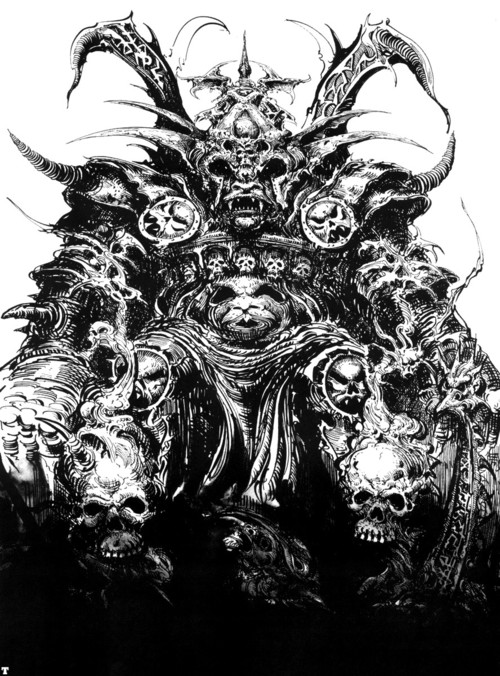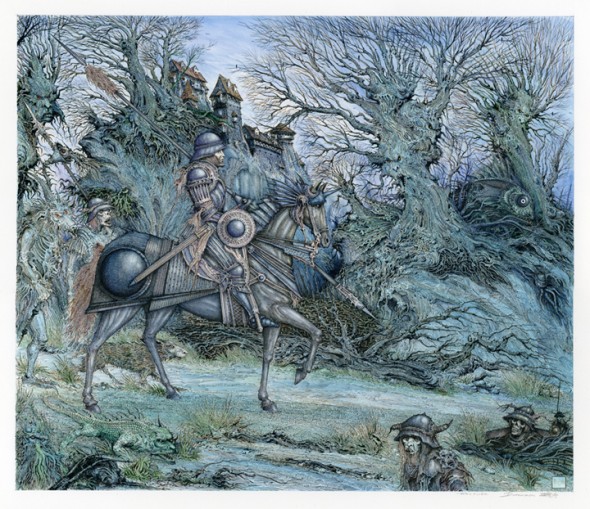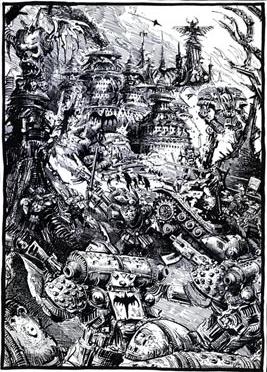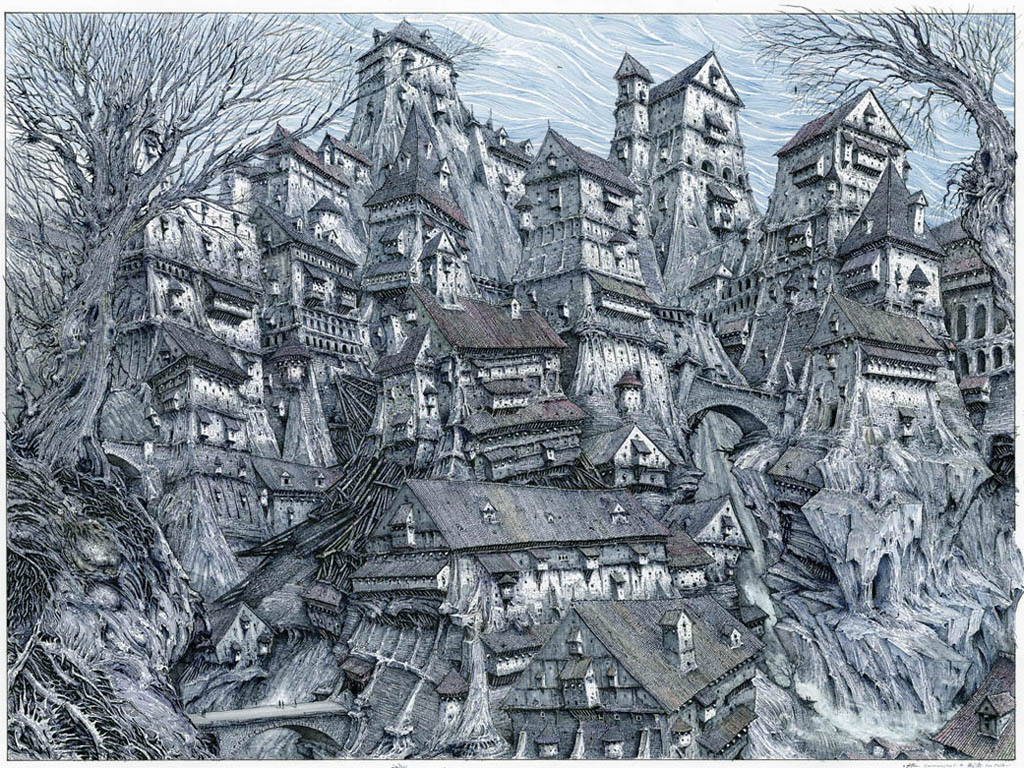‘Twitch once, Miller and you are king of the heap.
Twitch twice and you’re inconsolably lost.
Carry on and remember the twitch’
Last year as part of our Jagged Visions series, I wrote a gushing account of my personal experiences with Ian Millers work. Shortly after, Titan Books contacted me to say they’d read the piece and would I be interested in taking a look at a retrospective volume of Ian’s work that they had recently published. Naturally I leapt at the opportunity and given my current obsession with surfing the Fighting Fantasy zeitgeist, it seemed an appropriate time to post this review of a man who’s cover to House Of Hell caused me many sleepless nights all those years ago.
 The Art Of Ian Miller is a beautifully presented large format volume with over 300 pieces of artwork covering the broad span of Ian’s 40 year career. Brian Sibley provides an insightful foreword and makes reference to a collaborative unpublished work, a nightmarish reworking of Aesops fables that repulsed any publisher that looked upon it! Too bad we won’t ever see thatbuy cheap inflatable elephant toys. It is a true pleasure to see some of his more familiar pieces reproduced on this larger scale. The classic book covers and game supplement illustrations that I pored over as a squinting youth are magnified to reveal even more of the maddening intricacy and detail that is the signature of his work.
The Art Of Ian Miller is a beautifully presented large format volume with over 300 pieces of artwork covering the broad span of Ian’s 40 year career. Brian Sibley provides an insightful foreword and makes reference to a collaborative unpublished work, a nightmarish reworking of Aesops fables that repulsed any publisher that looked upon it! Too bad we won’t ever see thatbuy cheap inflatable elephant toys. It is a true pleasure to see some of his more familiar pieces reproduced on this larger scale. The classic book covers and game supplement illustrations that I pored over as a squinting youth are magnified to reveal even more of the maddening intricacy and detail that is the signature of his work.

Perhaps of most obvious interest to regular readers of this blog (and possibly his most immediately familiar material within this sphere) is the work he did for Games Workshop in the early to mid eighties. The grim darkness of the 40k universe is represented in the ‘Men, Monsters and Machines’ segment. The arcane and perverse clawing at one another to create new patterns of flesh and fear as hordes of demons dance gleefully on the periphery. Gothic Titans stride across necropolis battlefileds whilst dog faced chaotics howl beneath a crimson skies. Miller practices the alchemy of flesh and blood with the visceral hand of a master.
 But the real treat for me was a look at a number of pieces he’d worked on for private comissions. Of particular fascination were his portrayals and book covers inspired by H.P Lovecraft that I’d never seen before. Miller’s ability to generate a sense of the monolithic and forbidden that can simultaneously occupy the vast of the cosmic void and the dark at the back of the cupboard is breathtaking. There is a dark and undulating synergy that exists between Lovecrafts words and Millers visions. An understanding of terror that brings to mind an appropriate line from Lovecraft’s short story Pickman’s Model:
But the real treat for me was a look at a number of pieces he’d worked on for private comissions. Of particular fascination were his portrayals and book covers inspired by H.P Lovecraft that I’d never seen before. Miller’s ability to generate a sense of the monolithic and forbidden that can simultaneously occupy the vast of the cosmic void and the dark at the back of the cupboard is breathtaking. There is a dark and undulating synergy that exists between Lovecrafts words and Millers visions. An understanding of terror that brings to mind an appropriate line from Lovecraft’s short story Pickman’s Model:
‘Only the real artist knows the actual anatomy of the terrible or the physiology of fear—the exact sort of lines and proportions that connect up with latent instincts or hereditary memories of fright’ -HP Lovecraft
And whilst I have always felt a compulsion toward Miller’s perceptions of nature, particularly his clawed and twisted ancient woodlands, it is his cityscapes that draw my attention in this volume. Mervyn Peakes Gormenghast teeters on the brink whilst behind impregnable walls, Mordheim’s ramshackle architecture broods with diabolical angles and lunatic geometry. There is four sections taken from a larger drawing of the fictional city of Arkham that absolutely seethes, someday I would love to witness the whole piece as it was intended to be viewed.
 Mr Miler’s personal commentary and insights into his creative process, motivations and inspirations provide a fascinating and witty narrative. Of particular interest to a sober mind like myself was his thoughts about public perceptions of his work as being the outpourings of a narcotically altered state. How refreshing to learn that this was not the case:
Mr Miler’s personal commentary and insights into his creative process, motivations and inspirations provide a fascinating and witty narrative. Of particular interest to a sober mind like myself was his thoughts about public perceptions of his work as being the outpourings of a narcotically altered state. How refreshing to learn that this was not the case:
‘I have never needed any mind expanding substance to tap the subconcious; my childhood was a rich and whirligig world and I take from it freely’.
Clearly I am no art critic, not by a long chalk but I know what I like. Millers work stirs similar emotions in much the same way that Abrecht Durer or Gustav Dore does. Visual signals transmitted from that point where the veil is thinnest and the horrifying and the absurd collide to create visions of grotesque and compelling beauty. Miller remains the perennial outsider, the face at the darkened window forever peering in at humanity as we sleep. I imagine we all look like monsters to him.


Millers stuff was amongst the few artists back then where you could actually pore and ponder the plates in minute detail for hours as they’re so intricate, just letting the angles guide your eyes through the nightmares. His chaos stuff in particular as he’s even less bound by physics, for me at least. Some really fond memories there!
Will have to put this on the list of things to buy, was always more into Blanche’s early GW stuff but Miller’s work has rurally grown on me in the past few years.
I’ve always admired the way that Ian creates scenes from what appears to be a much greater story, and presents them with such individual style and unconventional mystery. I still have my copies of ‘Green Dog Trumpet’ and ‘Secret Art’ from all those years ago and am looking forward to getting a copy of this sometime soon.
Pingback: When worlds collide! or share a barycentre for a while | Critical Grumble